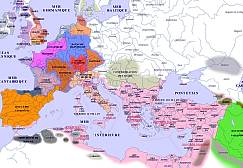
An Online Encyclopedia of Roman Emperors
Olympius (649-653 A.D.)
R. Scott Moore
Indiana University of Pennsylvania

An Online Encyclopedia of Roman Emperors
Olympius (649-653 A.D.)
R. Scott Moore
Indiana University of Pennsylvania
Revolt and Brief Reign
Constans II appointed Olympius as exarch of Ravenna in 649. Religious controversy had continued to divide the empire since the time of Heraclius. Heraclius, looking for a solution to the debate over the nature of Christ had seen monotheletism (one will) as a compromise between Chalcedonian or Orthodox supporters (two natures united without confusion) and Monophysites (one nature) and promulgated it in his Ekthesis in 638. This failed to stop the religious debate and had even generated further controversy. In an attempt to heal the rift between the monotheletes and supporters of Chalcedon, Constans II had the patriarch Paul issue a Typos in 648 that forbade further debate or argument concerning the nature of Christ. At the Lateran council in 649 under the guidance of Pope Martin, the assembled bishops condemned both the Ekthesis and Typos, as well as the patriarchs Sergius, Pyrrhus and Paul. Constans ordered Olympius to travel to Rome and arrest Pope Martin and force the bishops to accept and sign the Typos. Unable to coerce the bishops into accepting the Typos and unable to gain support from local forces against the pope, Olympius sided with Pope Martin and declared himself emperor. He soon gathered an army together and crossed into Sicily in 652. The Liber pontificalis reported that this movement towards Sicily was to attack the Saracens and that a mysterious disease attacked his army and eventually killed Olympius in 652. Modern scholarship has suggested that this attack on Sicily was an attempt to drive off Byzantine forces and separate Italy from the control of Constans II.[[1]]
[[1]] Alexander P. Kazhdan, Oxford Dictionary of Byzantium (New York 1991), s.v. "Olympios," by Paul A. Hollingsworth; George Ostrogorsky, Geschichte des byzantischen Staates (Munich, 1963), 119.
Primary Source Bibliography
Liber pontificalis.
Theophanes. Chronographia.
Bibliography
Haldon, J.F. Byzantium in the Seventh Century: the transformation of a culture. Cambridge, 1990.
Herrin, Judith. The Formation of Christendom. Princeton, 1987.
Kaegi, Jr. Walter Emil. Byzantine Military Unrest, 471-843: an interpretation. Amsterdam, 1981.
Kazhdan, Alexander P. Oxford Dictionary of Byzantium. New York, 1991. S.v. "Olympios" by Paul A. Hollingsworth.
Ostrogorsky, George. Geschichte des byzantischen Staates. Munich, 1963.
Stratos, A.N. Byzantium in the Seventh Century. Amsterdam, 1968.
Treadgold, Warren. A History of Byzantine State and Society. Stanford, 1997.
Vasiliev, A.A. History of the Byzantine Empire. Madison, Wisconsin,
1952.
Copyright (C) 1999, R. Scott Moore. This file may be copied on the condition that the entire contents, including the header and this copyright notice, remain intact.
Comments to: R. Scott Moore
Updated: 26 May 1999
For more detailed geographical information, please use the DIR/ORBAntique and Medieval Atlas below. Click on the appropriate part of the map below to access large area maps.
